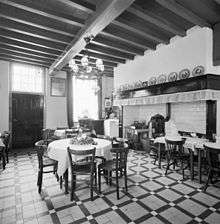Bressummer
A bressummer, breastsummer, summer beam (somier, sommier, sommer, somer, cross-somer, summer, summier,[1] summer-tree,[2] or dorman, dormant tree) are load bearing beams in a timber framed building. The word summer derived from sumpter or French sommier, "a pack horse", meaning "bearing great burden or weight". "To support a superincumbent wall", "any beast of burden", and in this way is similar to a wall plate.

A typical summer beam with slender joists in the ceiling of a cafe in the Netherlands. Image: Cultural Heritage Agency of the Netherlands
The use and definition of these terms vary but generally a bressummer is a jetty sill and a summer is an interior beam supporting ceiling joists, see below:
- (UK) In the outward part of the building, and the middle floors (not in the garrets or ground floors) into which the girders are framed. In the inner parts of a building, such beams are called "summers". It is part of the timber frame construction in the over-hanging upper story in jettying.[3]
- (UK) "Horizontal beam over a fireplace opening (alternatively lintel, mantel beam), or set forward from the lower part of a building to support a jettied wall, a jetty bressummer".[4]
- (UK) "...usually the sill of the upper wall above a jetty; otherwise any beam spanning an opening and supporting a wall above."[5] also called a "jetty sill".
- (UK) Breastsummer is a beam in a wall which carries the load over a large opening derived from breast being in the front, mid-level and summer: "A horizontal, bearing beam in a building; spec. the main beam supporting the girders or joists of a floor...".[6]
- "a main piece of timber that supports a building, an architrave between two pillars"[7]
- "Breast-Summer, an architectural term for a beam employed like a lintel to support the front of a building, is a corruption of bressumer..."[8]
- (U.S.) "Summer beam: A large timber spanning a room and supporting smaller floor joists on both sides."[9]
- (U.S.) "Summer beam. Heavy main horizontal beam, anchored in gable foundation walls, that supports forebay beams and barn frame above."[10]
References
- A Dictionary of the Old English Language
- 1913 Webster
-

- Alcock, N. W. Recording timber-framed buildings: an illustrated glossary. London: Council for British Archaeology, 1989. G4, 14h, 15b. ISBN 1872414729
- Harris, Richard. Discovering timber-framed buildings. 2d ed. Aylesbury: Shire Publications, 1979. 94. ISBN 0747802157.
- "Breastsummer" def. 1. Oxford English Dictionary Second Edition on CD-ROM (v. 4.0) © Oxford University Press 2009
- Bailey; Kennett, 1695
- Folk-etymology: A Dictionary of Verbal Corruptions Or Words... quoting Parker's Glossary of Architecture
- Sobon, Jack. Build a classic timber-framed house: planning and design, traditional materials, affordable methods. Pownal, Vt.: Storey Communications, 1994. 191.ISBN 0882668412
- Ensminger, Robert F.. The Pennsylvania barn: its origin, evolution, and distribution in North America. Baltimore: Johns Hopkins University Press, 1992. 392.
This article is issued from Wikipedia. The text is licensed under Creative Commons - Attribution - Sharealike. Additional terms may apply for the media files.